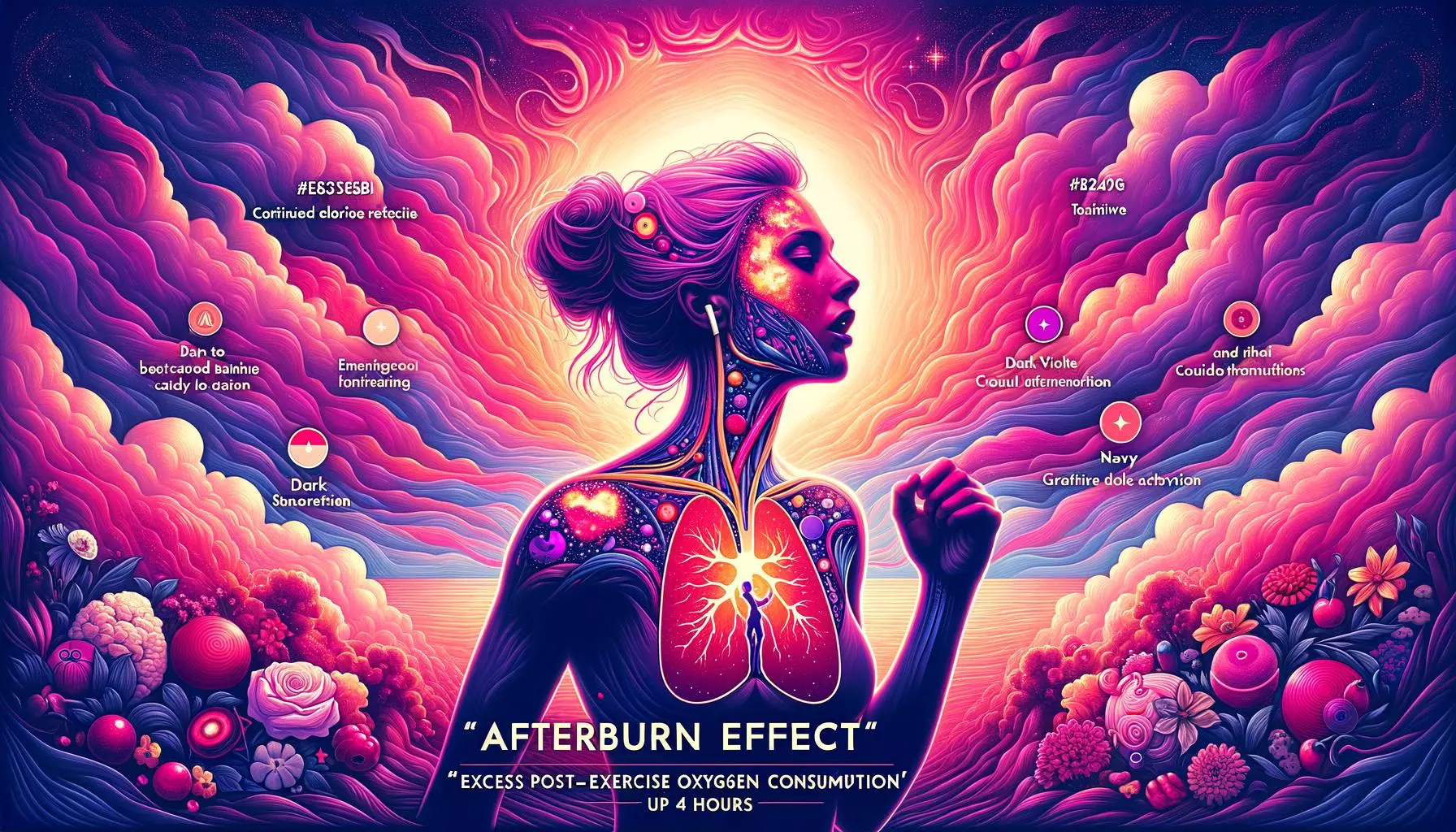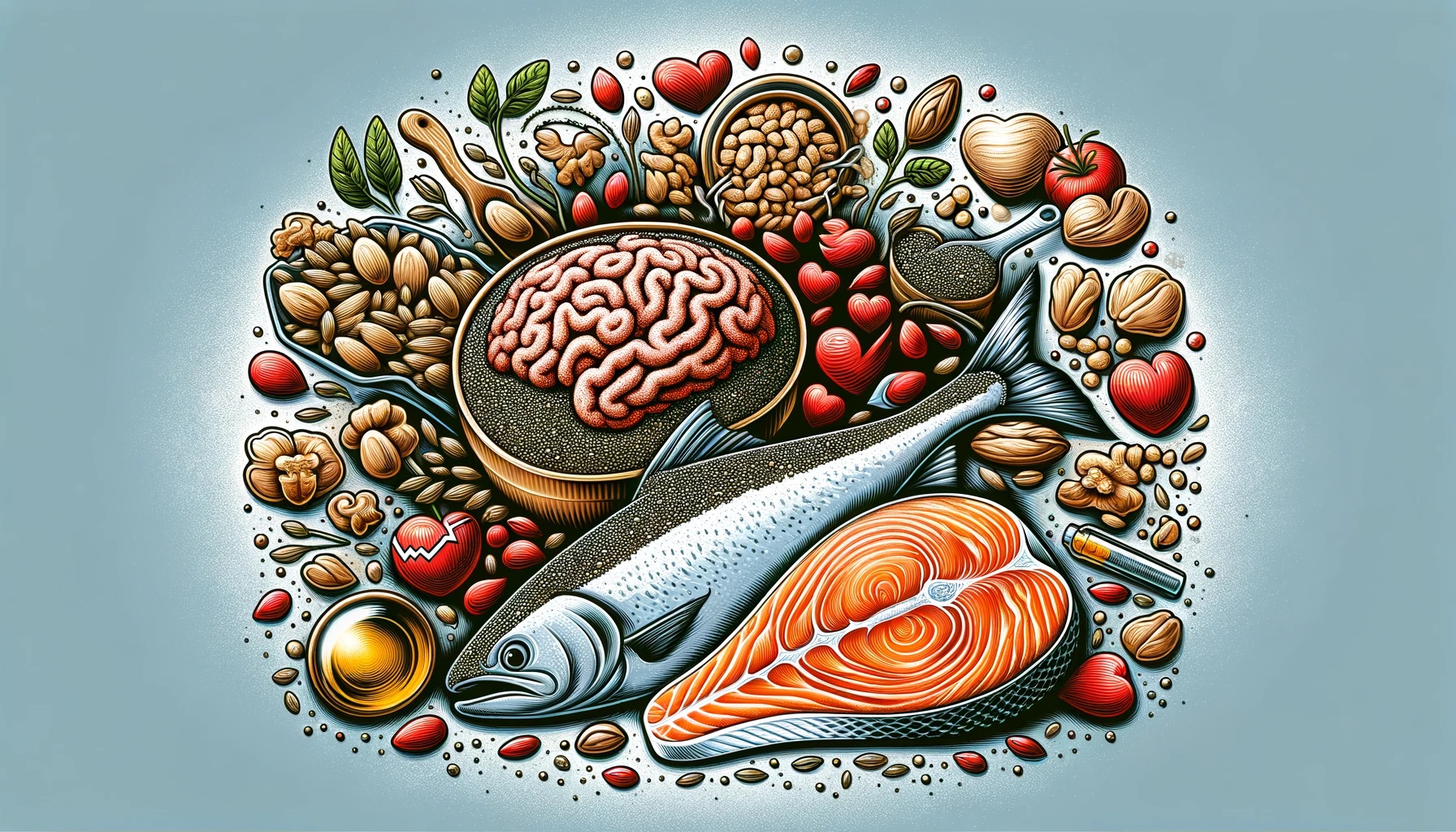· fitness · 16 min read
Unveiling the Afterburn Effect: Unlock Continuous Calorie Burn
Explore the science behind the afterburn effect and how it influences fitness and weight loss. Learn about EPOC and its role in calorie burning post-workout.

In This Post
The Fact Why Should I Care How To Put In Action Start Tomorrow Guide How does it effect my ability to focus How does it impact my daily life How does it help me make friends How does it help me manage stress How does it effect my mood Summary: Remember Refresher Checklist The Full Research Article CitationsPrint Out The Tomorrow Checklist!
Sign up for our newsletter and receive a copy today, so that, you can start tomorrow! Or the next day, or the day after that. I forget everything and starting things is hard at least for me so these checklists are godsend.
Print Out The Remember Refresher Checklist!
Sign up for our newsletter and download your own copy of the Remember Refresher Checklist, so that, you can easily put it on your fridge and help you stay on target towards your WHY. Every little bit helps.
Introduction to the Afterburn Effect

The afterburn effect, scientifically known as Excess Post-Exercise Oxygen Consumption (EPOC), is a phenomenon that has garnered significant attention in the fitness world for its potential to enhance weight loss and overall fitness. This effect propels your body into a state where it continues to burn calories at an elevated rate long after you’ve finished your workout. The underlying principle of the afterburn effect is deeply rooted in the physiological responses our body undergoes during and post-exercise.
The Science Behind Afterburn
To dive deeper, when we engage in strenuous activity, our body utilizes oxygen to generate the energy required for that exercise. However, during high-intensity training, like High-Intensity Interval Training (HIIT), the body demands more oxygen than what is readily available. This creates an ‘oxygen debt’ that needs to be ‘repaid’ post-workout, leading to continued calorie burn as the body works harder to restore itself to a resting state. This process involves various metabolic pathways and can significantly impact your overall caloric expenditure.
The physiological mechanisms at play include replenishing energy reserves, repairing cell damage, and addressing the built-up lactic acid. As a result, your metabolism remains elevated, effectively turning your body into a calorie-burning machine well beyond the confines of your workout session.
Importance in Fitness and Weight Loss
Incorporating workouts that leverage the afterburn effect can be a game-changer for individuals looking to enhance their fitness levels or achieve weight loss goals. The ability to continue burning calories at a heightened rate post-exercise means that you effectively get more out of each workout session. This continuous calorie burn contributes significantly to overall caloric deficit, a crucial factor in weight loss.
Moreover, understanding the afterburn effect can guide the design of your exercise regimen to maximize calorie burn and improve metabolic health. It underscores the importance of not just the duration of exercise, but also the intensity, making a compelling case for including HIIT and other high-intensity workouts in your fitness plan.
Checklist for Incorporating the Afterburn Effect in Your Workouts:
- [] Incorporate High-Intensity Interval Training (HIIT) sessions
- [] Ensure a mix of cardiovascular and strength training
- [] Focus on the intensity of the workouts, not just duration
- [] Allow adequate rest and recovery between intense workouts
- [] Hydrate well and follow a balanced diet to support recovery and enhance performance
Understanding the afterburn effect not only empowers you to optimize your fitness strategy for better results but also encourages a more scientific approach to exercise, emphasizing efficiency and the intelligent use of our body’s physiology to achieve health and fitness goals.
How EPOC Works

Understanding Excess Post-Exercise Oxygen Consumption
The concept of Excess Post-Exercise Oxygen Consumption (EPOC), popularly known as the afterburn effect, is a cornerstone in understanding how our bodies continue to burn calories even after we’ve finished exercising. In simple terms, EPOC represents the oxygen our body needs to restore itself to its pre-exercise state. This process requires energy, which is derived from burning calories, hence the continuous calorie burn post-workout.
When we engage in exercise, particularly strenuous activities, our body consumes more oxygen than when at rest. This increase in oxygen intake boosts our metabolism, leading to a higher rate of calorie burn. However, what’s fascinating is that this elevated metabolic rate doesn’t halt the moment we stop exercising. Instead, it persists for a period, contributing to additional caloric expenditure – this is the essence of the afterburn effect.
Factors Influencing the Afterburn Effect
The intensity and duration of exercise are key determiners of the magnitude of the EPOC experienced. However, several other factors also influence this physiological phenomenon.
- Type of Exercise: High-Intensity Interval Training (HIIT) and strength training are more likely to generate a significant afterburn effect compared to steady-state cardio exercises.
- Duration of Exercise: Longer bouts of exercise can lead to a more prolonged EPOC, though it’s crucial to balance duration with intensity to avoid overtraining.
- Fitness Level: Individuals with a higher fitness level may experience a different EPOC response compared to those who are less fit. This is because their bodies are more efficient at recovering from exercise.
- Metabolic Rate: Baseline metabolic rate can also impact EPOC. People with a higher metabolic rate naturally burn more calories, potentially leading to a greater afterburn effect.
- [ ] Engage in HIIT or strength training sessions to maximize the afterburn effect.
- [ ] Aim for a workout duration that challenges you without leading to overtraining.
- [ ] Gradually increase the intensity of your workouts to improve your fitness level and EPOC
response.
- [ ] Monitor your basal metabolic rate to understand how it might affect your afterburn
potential.
The afterburn effect, while offering a boost to caloric expenditure, should not be the sole focus of an exercise regimen. It represents a component of the broader spectrum of benefits that physical activity provides, including improved cardiovascular health, enhanced muscular strength, and better overall well-being. To truly maximize the benefits of EPOC and achieve substantial weight loss or fitness improvements, it’s essential to consider other factors such as nutrition, recovery, and the consistency of your workout routine.
Maximizing the Afterburn Effect

The quest for efficient fitness routines that maximize calorie burn doesn’t end when you step off the treadmill or finish that last rep. Through understanding and leveraging the afterburn effect, or Excess Post-Exercise Oxygen Consumption (EPOC), you can continue to burn calories long after your workout is over. This part of our deep dive into EPOC focuses on practical strategies to enhance this metabolic afterburn.
Workout Types That Trigger More EPOC
High-Intensity Interval Training (HIIT) stands out as the champion of maximizing the afterburn effect. This form of exercise alternates short bursts of intense activity with periods of rest or lower-intensity exercise. These powerful bursts push your body to its limits, not only improving your cardiovascular health but also igniting your metabolism to keep burning calories at an elevated rate post-workout.
Strength training, especially circuit training involving multiple muscle groups with minimal rest, can also significantly increase EPOC. Lifting heavier weights or performing bodyweight exercises at a high intensity forces your muscles to work harder, increasing the oxygen demand and calorie burn well after your session ends.
For those who enjoy a challenge, mixed martial arts, sprinting, and vigorous swimming offer dynamic and potent ways to fuel the afterburn effect. These activities blend high intensity with varying movements, engaging different muscle groups and keeping your metabolism on its toes.
Planning Your Exercise Regimen for Optimal Afterburn
Designing an exercise regimen that maximizes EPOC doesn’t have to be complex. Here is a simple checklist to help you plan:
- Include at least two HIIT sessions per week, focusing on different muscle groups each time.
- Mix in strength training 2-3 times a week, with emphasis on compound movements like squats,
deadlifts, and bench presses.
- Incorporate one day of rest between high-intensity workouts to allow for recovery and muscle
repair.
- Gradually increase workout intensity and duration over time to continue challenging your
body and improving the afterburn effect.
- Keep track of your workouts and progress. Adjust as necessary to avoid plateaus and maintain
continuous calorie burn.
Implementing a strategic mix of high-intensity and strength training exercises, with adequate recovery and progression, lays the foundation for a fitness regime that not only promotes weight loss and fitness but also keeps the calorie-burning furnace going long after you’ve stopped sweating.
In essence, maximizing the afterburn effect is about working smarter, not necessarily harder. By focusing on workout types that trigger more EPOC and planning your exercise regimen effectively, you can enjoy the benefits of your hard work for hours, if not days, after leaving the gym. The key is consistency, intensity, and giving your body the right challenges to adapt and grow stronger, ensuring your metabolism stays accelerated for continuous calorie burn and overall fitness improvement.
The Role of Nutrition and Recovery

How Diet Affects Post-Workout Calorie Burn
The food we eat plays a crucial role in determining how our body responds to exercise, including the afterburn effect, or Excess Post-Exercise Oxygen Consumption (EPOC). Consuming the right nutrients can fuel the continuous calorie burn and support muscle recovery. Foods rich in proteins and complex carbohydrates are particularly effective in enhancing the metabolic rate post-exercise. For instance, a lean chicken breast or a quinoa salad can provide the essential nutrients needed for recovery and maintaining a higher level of caloric expenditure. It’s about creating a balance that supports your fitness goals while catering to the nutritional impact on your body’s ability to regenerate and continue burning calories.
The Importance of Rest and Recovery in EPOC
Recovery and rest are as essential as the workout itself in maximizing the afterburn effect. When you allow your body to rest, you enable it to repair and build the muscles that were stressed during exercise. This process requires energy, contributing to EPOC. Thus, incorporating sufficient sleep and rest days into your exercise regimen ensures you’re getting the full benefit of every workout. Regular, quality sleep enhances the physiological processes of EPOC, making it a critical component of any fitness strategy aimed at weight loss and improved metabolic health.
Supplements and Their Impact on Afterburn
Supplements can play a supporting role in enhancing the afterburn effect, though they’re no substitute for a healthy diet and exercise. Certain supplements, like BCAAs (Branched-Chain Amino Acids), caffeine, and protein powders, may help increase your metabolic rate and support muscle recovery. However, it’s important to approach supplements with caution and consult a healthcare professional before adding them to your routine. The goal is to complement your diet and exercise, not rely on these aids exclusively.
- [ ] Consult a healthcare professional before taking new supplements.
- [ ] Consider BCAAs to support muscle recovery.
- [ ] Use caffeine moderately to boost metabolism.
- [ ] Incorporate a high-quality protein powder for muscle repair.
- [ ] Always prioritize a balanced diet and exercise regimen.
Myths and Misconceptions About EPOC
Despite its benefits, there are several myths surrounding the afterburn effect that need to be addressed:
- Myth 1: EPOC burns thousands of extra calories. Reality: The calorie burn is modest, contributing to long-term weight loss goals.
- Myth 2: Only high-intensity workouts can trigger EPOC. Reality: While HIIT and strenuous activities are more effective, any form of exercise that increases your heart rate can contribute to EPOC.
- Myth 3: Supplements alone can enhance EPOC. Reality: Supplements may support the afterburn effect but are not effective without the combination of proper diet and exercise.
The key to maximizing the afterburn effect lies in understanding the complex interplay between exercise, nutrition, and recovery. By focusing on a balanced approach that combines these elements, individuals can enhance their fitness levels, boost calorie burn, and achieve their weight loss and health goals more effectively.
FAQs on the Afterburn Effect

The Afterburn Effect, formally known as Excess Post-Exercise Oxygen Consumption (EPOC), is a fascinating physiology process that continues to burn calories long after your workout session has ended. This phenomenon has garnered a lot of attention for its role in weight loss, fitness, and overall health. In this section, we aim to peel back the layers and answer some of the most commonly asked questions about the Afterburn Effect.
How Long Does the Afterburn Effect Last?
One of the most burning questions (pun intended) about EPOC is the duration of its impact. The Afterburn Effect can last anywhere from a few hours to over 24 hours post-workout. Factors such as the intensity and duration of the exercise significantly influence how long your body continues to burn calories at an elevated rate.
Key points to remember regarding the duration of the Afterburn Effect include the type of workout—High-Intensity Interval Training (HIIT) often results in a longer-lasting EPOC—and the importance of pushing your limits in a safe manner to maximize this benefit.
Can Low-Intensity Exercises Also Lead to EPOC?
While the Afterburn Effect is mostly associated with strenuous activity and workout intensity, low-intensity exercises can also contribute to EPOC, albeit to a lesser extent. It’s the accumulation of several factors, including oxygen intake, metabolic rate, and the overall duration of the exercise, that determines the presence and extent of the Afterburn Effect. Incorporating consistent, moderate activities into your fitness regimen can help trigger EPOC and aid in continuous calorie burn.
How Do I Track Calories Burned Post-Workout?
To monitor the calories burned after your workout effectively, utilizing a fitness tracker can be incredibly helpful. These devices measure various parameters such as heart rate, steps taken, and even sleep quality to provide a more holistic view of your health. However, tracking the specific calories burned due to EPOC requires understanding that these devices can offer estimates rather than precise figures.
- Use a reliable fitness tracker or smartwatch
- Regularly check your heart rate post-exercise
- Note the duration and intensity of your workouts
- Monitor your progress over weeks, not days
- Combine with regular weight and health tracking for a more comprehensive overview
Understanding the Afterburn Effect and its myriad benefits is a step closer to optimizing your health and fitness goals. As we have explored, factors such as workout intensity, the inclusion of both high and low-intensity exercises, and the use of technology to monitor outcomes play vital roles in maximizing the continuous calorie burn that EPOC promises. Whether you’re new to fitness or looking to enhance your exercise regimen, incorporating knowledge about EPOC can lead to more rewarding workouts and sustainable health benefits.
Conclusion - Harnessing the Power of Afterburn

As we bring our exploration of the afterburn effect, formally known as Excess Post-Exercise Oxygen Consumption (EPOC), to a close, we recognize its critical role in achieving fitness and weight loss goals. This phenomenon, which allows your body to continue burning calories long after your workout has ended, underscores the importance of incorporating certain exercises into your routine to maximize caloric expenditure. Here, we summarize the key takeaways from our discussions and offer advice on implementing this knowledge into your daily workout routine.
Key Takeaways
- Understanding EPOC: The afterburn effect is a result of your body’s effort to restore itself to its pre-exercise state, which includes replenishing oxygen stores, removing lactic acid, and repairing muscles. This process requires energy, meaning your body continues to burn calories at an elevated rate post-workout.
- Workouts That Trigger EPOC: High-Intensity Interval Training (HIIT), strength training, and any form of strenuous activity that pushes your body out of its comfort zone can significantly enhance the afterburn effect. It’s the intensity and not necessarily the duration of exercise that plays a key role in EPOC.
- The Role of Nutrition and Recovery: A balanced diet and adequate rest are essential for optimizing the afterburn effect. Your body needs fuel to recover, and giving it the right nutrients can enhance calorie burn. Moreover, allowing your body to rest and recover is just as vital as the workout itself.
- Overcoming Misconceptions: EPOC is not a silver bullet for weight loss but an effective tool when used alongside a comprehensive fitness plan that includes a balanced diet and regular exercise.
Implementing the Afterburn Effect into Your Daily Workout Routine
Incorporating the lessons learned about the afterburn effect into your daily workouts requires planning and discipline. To make this easier, here’s a simple checklist to help you stay on track:
- [ ] Schedule your high-intensity workouts (HIIT or strength training) for 3-4 days a week.
- [ ] Ensure each workout pushes you sufficiently to feel the burn, indicating you’re working
at the right intensity.
- [ ] Balance your exercise regimen with adequate rest days to prevent overtraining and
support recovery.
- [ ] Monitor your diet to ensure you're consuming the right balance of nutrients to support
recovery and maximize EPOC.
- [ ] Keep track of your progress and adjust your workouts as needed to continuously challenge
your body.
By following these steps, the afterburn effect can seamlessly become a part of your fitness journey, not only enhancing your calorie burn but also improving your overall physical health. Remember, the key to harnessing the power of afterburn lies in the intensity of your workouts, balanced nutrition, and adequate rest and recovery.
Embracing the afterburn effect in your fitness routine is about more than just burning extra calories; it’s about adopting a holistic approach to exercise that values the importance of recovery and sustainable practices. As you continue to challenge your body and push it to new heights, you’ll find the afterburn effect to be a valuable ally in achieving your health and fitness goals.
3 Relevant Links - Afterburn Effect

In your journey to understand and harness the afterburn effect for continuous calorie burn, utilizing high-quality, research-backed resources is essential. The complexities of Excess Post-Exercise Oxygen Consumption (EPOC), its factors, and how to effectively include it in your fitness and weight loss plans can be better grasped with expert guidance. Below are three highly reputable sources that offer deep insights into the afterburn effect, its physiological basis, and practical advice on how to maximize its benefits.
American Council on Exercise (https://www.acefitness.org) - Dive into the pool of comprehensive research on EPOC and how exercise intensity plays a pivotal role in maximizing the afterburn effect. Their resources are not only reliable but also accessible, making it easier for fitness enthusiasts to apply the concept of afterburn in their workout routines.
Recommended Anchor Text: “Research on EPOC and Exercise Intensity”
National Institutes of Health (https://www.ncbi.nlm.nih.gov) - This portal offers a vast array of studies touching on various aspects of health, including the effects of High-Intensity Interval Training (HIIT) on EPOC. Through their search feature, you can find peer-reviewed articles and studies that delve into the science behind metabolism, strenuous activity, and post-workout recovery.
Recommended Anchor Text: “Studies on the Effects of HIIT on EPOC”
Harvard Health Publishing (https://www.health.harvard.edu) - As one of the leading voices in health and wellness, Harvard Health Publishing provides insightful articles that explain the role of metabolism in weight loss and EPOC. Their content is authored by health professionals and offers practical tips on incorporating the principles of EPOC in your fitness journey.
Recommended Anchor Text: “Understanding the Role of Metabolism in Weight Loss and EPOC”
To ensure these resources are effectively used, consider the following checklist when navigating through the wealth of information available:
- [ ] Identify articles that directly relate to the afterburn effect and EPOC.
- [ ] Look for studies or articles that discuss the impact of workout intensity and duration
on calorie burn.
- [ ] Pay attention to information on the role of recovery and nutrition in enhancing the
afterburn effect.
- [ ] Search for practical tips or exercise regimens that facilitate maximum EPOC.
- [ ] Take note of any misconceptions or myths debunked by credible research.
- [ ] Evaluate the findings and advice in light of your fitness goals and workout preferences.
Understanding and applying the principles of the afterburn effect requires a blend of knowledge from various aspects of fitness, including exercise regimen, metabolic rate, oxygen intake, and the physiological mechanisms behind EPOC. Utilizing the above resources alongside this comprehensive checklist can significantly impact your fitness journey, turning every workout session into an opportunity for continuous calorie burn and an enhanced state of health.





